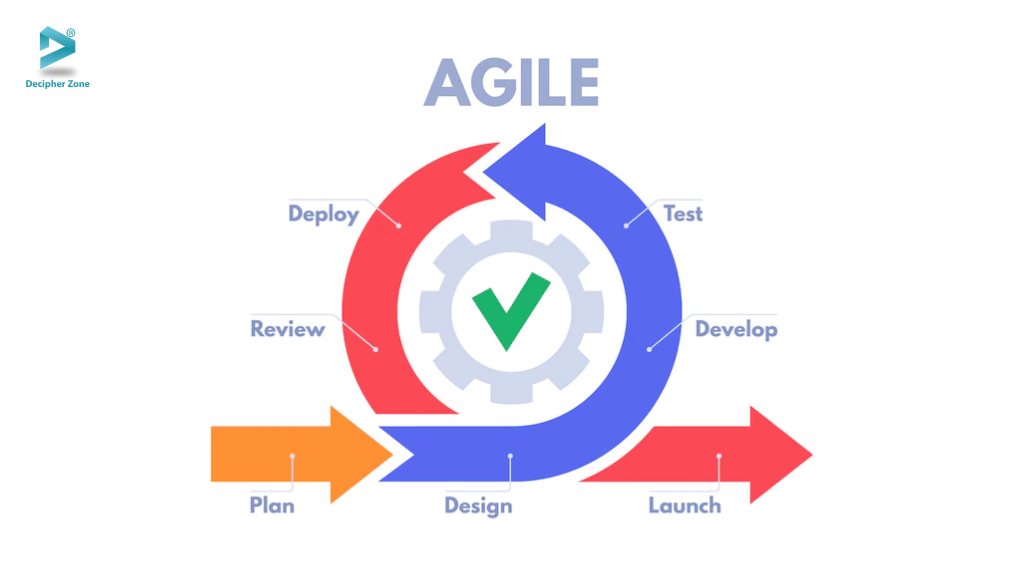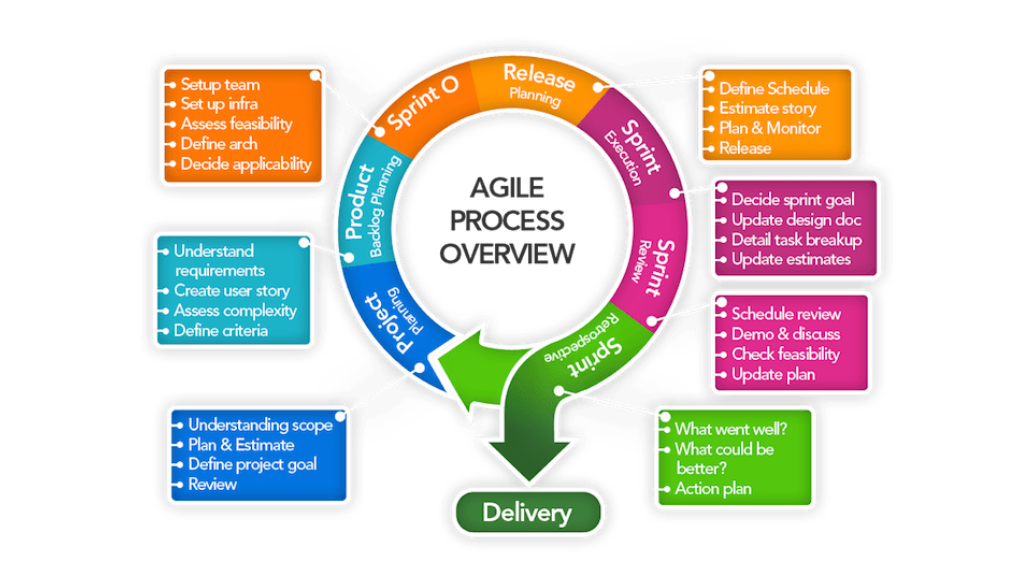6 Stages of the Agile Development Lifecycle. Words like flexibility and adaptability might come to your mind when you hear the term “Agile”. And that’s somewhat right, as the Agile teams are designed to adapt to changes quickly with ease. Agile teams adopt constant changes via a repetitive approach to software design and development.
Over the years, several businesses have realized that traditional methods don’t match the pace of modern world technologies. And they need to be adaptable and nimble to meet the changing marketplace driven by the users. As we know the Waterfall approach might have worked wonderfully in the past projects, but to match the pace of the rapidly changing industry, it makes more sense to shift to Agile.
That’s why in this blog, we will help you in understanding the basics and life cycle of agile methodology.
What Is Agile Methodology?
The Agile methodology is the way or manner to divide the project into small phases and make it easily manageable. It includes constant stakeholder collaboration and continuous improvement at each phase. The main values of Agile methodologies are:
-
Interactions and individuals above tools and processes
-
Customer collaborations above negotiation of contract
-
Working software above comprehensive documentation
-
Responding to changes above following a plan
The word agile in today’s world can refer to different values and frameworks including Kanban, Scrum, Adaptive Project Framework (APF), and Extreme Programming (XP).
-
Kanban: A project management approach where physical representations (usually on whiteboards, online apps, or sticky notes) of tasks are created by team members. Tasks move from predetermined phases to track progress and detect barriers.
-
Scrum: A methodology to manage projects where Scrum master led small teams and clears common roadblocks to complete tasks. Work is done in sprints (small cycles) and the team meets regularly to discuss task progress and identify obstacles.
-
Adaptive Project Framework (APF): APF is the project management methodology where teams work in stages and analyze each one.
-
Extreme Project Management (XPM): In the XPM methodology, the plan, budget, and deliverables can be modified according to the changing needs no matter how much work has been done on the project.
Read: Running Stateful Applications on Kubernetes
What is Sprint in Agile Development?
In agile development methodology, a sprint is a short, repeatable, broken down phase of the project that can be one to four weeks long. The length and number of the sprint should be decided at the beginning of the project, where each sprint should result in a prototype, draft, or workable version of the final product. Put simply, spring breaks down a software development project into bite-sized pieces.
Read: What is Custom Software Development
Benefits of Agile Methodology
Now that we know what agile methodology is, let’s understand why a business should adopt Agile for managing their projects.
-
Better Control
With features like transparency, quality-control and feedback integrations, Agile offers managers better control of the project. Throughout the implementation phase of the project, the quality of the software is ensured by the stakeholders by using advanced reporting tools and techniques for daily progress reports.
-
Increased Flexibility
Implementing agile in the project development team gives them remarkable flexibility. In agile development methodology, the team works in sprints that are not only easily attainable but also flexible enough to allow developers to make changes even on short notice.
-
Continuous Improvement
Striving for continuous improvement is one of the core principles of Agile. As the agile methodology works in recursiveness, each sprint will be more promising than the previous one and will contain no iterative mistakes. It encourages an open culture for collaboration and idea exchange allowing team members to learn and improve from each other’s experiences.
-
Better Project Predictability
As agile teams work in sprints, the fixed durations make it easier for the manager to analyze the performance of the team and accordingly assign resources. Moreover, it becomes easier to estimate cost as the prediction is done for short periods rather than long-term.
-
Reduced Risks
All the progress made during a sprint is assessed by developers regularly to have improved the visibility of the project which helps in identifying errors and obstacles easily. Hence majorly all the issues are tackled immediately, building an effective and powerful risk mitigation process.
-
Product Quality
The agile methodology works in an iterative manner for project management that improves the process upon every interval repetition. The consistent focus on quality control and improvement leads to the development of high-quality products.
-
Customer Satisfaction
As the stakeholders are involved in the project development lifecycle, the feedback they give can help in assessing the final product according to their needs. These custom-made deliverables are more likely to improve customer satisfaction and retention.
12 Agile Software Development Principles
The twelve principles of Agile methodology Software Development are as follows:
-
Continuous and early delivery of valuable software ensures customer satisfaction.
-
Even at late stages of development, changes in requirements are welcome.
-
Frequent delivery of working software (within weeks then months)
-
Regular, close coordination between the development team and stakeholders.
-
Developing projects around motivated and trusted people
-
The best communication form for a co-location team is a face-to-face meeting.
-
The software's operation is used to gauge progress.
-
Development should be sustainable and maintain a constant pace.
-
Regular focus on technical excellence and design to improve agility.
-
Simplicity - The art of increasing the volume of incomplete work is important
-
Self-organizing teams help in acquiring the best designs and architectures to fulfill requirements.
-
Agile teams should reflect on becoming more effective while adjusting accordingly at a regular interval.
Agile Development Lifecycle
The development life cycle of agile methodology is an organized series of phases that a project goes through from start to end. These stages are concept, inception, release, maintenance, and retirement. However, the life cycle may slightly differ depending on the agile methodology determined by the team.

So let’s examine each of these stages of the Agile lifecycle in detail.
1. Concept
The first phase of the agile development lifecycle is the concept. In this phase, the stakeholder will determine the objective and scope of the software. A document that outlines the key requirements of the product will be created by the product owner. This document will also determine the time required to complete this job as well as business opportunities.
However, it is advisable to keep minimum requirements as they can be included in the later phases. This will help in deciding whether the product is feasible or not.
2. Inception or Requirement Identification
After outlining the concept, the next step is to create the software development team. The product owner will verify the availability of co-developers and choose the best people for the project's success. The product owner will also provide the chosen front-end and back-end developers with the required resources and tools.
Read:How to Deploy Microservices Using Serverless Architecture
Then the team can design the mock-up for the user interface while creating the architecture for the project. In this stage, the stakeholders are again involved to gain all the requirements on a diagram and determine the functionality of the project. Moreover, regular checks will help to understand whether all the requirements are incorporated into the design process or not.
3. Iteration or Development
The third phase of the agile development process is development or iteration. This one is the longest of all as it carries all the bulk work. Now the development team will start working on combining all the requirements of the product gathered in the concept and inception phase. It goes under several reviews and revisions for improvement until finalized.
In the development or iteration phase, the following steps are accomplished:
-
The association of the team with clients.
-
Iterations and functionalities are prioritized and implemented.
-
Each sprint/iteration should be closely examined and developed.
-
Delivering regular working software releases.
-
Ensuring product quality by testing at regular intervals.
4. Release
Before releasing the product, the quality assurance team runs some tests that assure the functionality of the software. The QA team members will test the software to make sure that the code is clean and if there are any potential errors or bugs, they are addressed by the development team rapidly.
Read: Kubernetes vs Docker Swarm
This phase also supports regular releases and improvement through user feedback. The users and clients are trained on how to use the software. And once all of this is complete, the product is released into production.
5. Maintenance
Now the software is completely deployed and accessible by the customers. So the product comes into the maintenance phase. In this phase, the development team provides regular support to the customer to ensure that the software runs smoothly without any bugs. Over time, new iterations can happen to make the existing product more convenient and useful for the customers.
6. Retirement
The retirement of a product can be triggered by either new software being introduced, or by a system having become outdated or inconsistent with the organization after some time. Users will first be notified that the software is being retired. When the system is replaced, users will be transferred to the latest system. Last but not least, the developers will conduct the remaining activities and discontinue supporting the old software. Agile includes multiple iterations to refine deliverables and achieve great results.
The Workflow of Agile Iteration
The iteration of agile methodology is often two to four weeks in duration and has a completion date. The workflow of the iteration includes the below-mentioned five phases:
-
Planning requirements
-
Delivering iteration
-
Incorporating feedback

Every phase of the agile product will have several iterations as developers will repeat the processes to refine their projects and create superior quality software.
Throughout their product's life cycle, software development teams rely on the Agile life cycle to stay on track. Agile project management platforms and agile project management training can support all activities in the Agile cycle by offering appropriate resources and tools to team members.
Conclusion
Although, due to the known costs and predictability, some developers still prefer the waterfall method. But the strength of the Agile methodology is in the flexibility it provides for the product to evolve throughout the development cycle. As the developers can roll with the demands of the stakeholders, the completed product will be of high quality.
Read: How Docker Container Works
As with other Agile processes, there are no hard and fast rules. The Agile system development life cycle described above is not set in stone and can be updated and adjusted as necessary within your business or project.
Transitioning from Waterfall to Agile can be tough for some organizations. It might be difficult to truly commit, specifically if you are under time or money constraints.
Read: Tips To Hire The Best Developers
This is why interaction and collaboration are critical at all stages of the Agile Life Cycle. You will be able to completely implement Agile much more easily if you outline what is wanted and doable during initial planning. You can get programming assignment help from Cwassignments experts.
Wanna hire an agile development team for your project? Then hire developers from companies like Decipher Zone now!

